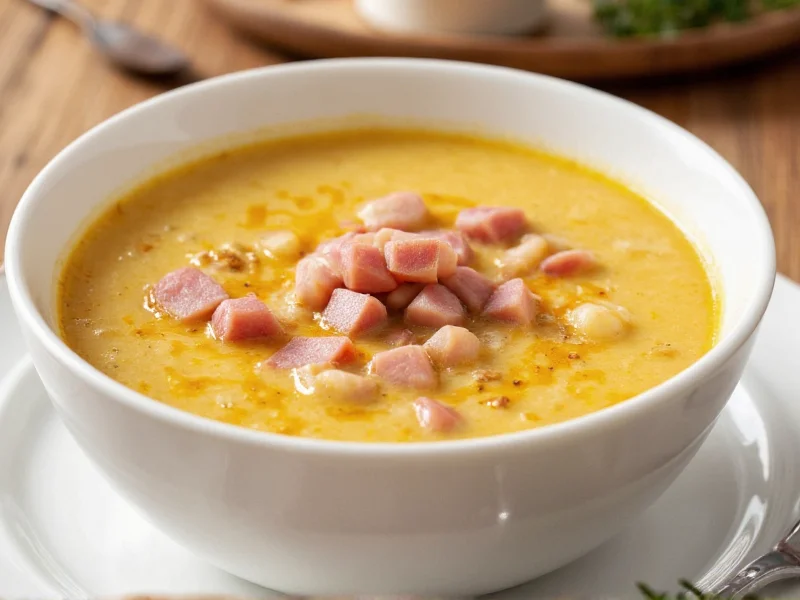The Ultimate Guide to Perfect Potato Ham Soup
Nothing beats a bowl of warm potato ham soup on a chilly day. This classic comfort food combines humble ingredients into something extraordinary. Whether you're using leftover holiday ham or starting from scratch, mastering this soup ensures you'll have a go-to recipe that satisfies every time.
Essential Ingredients for Flavorful Potato Ham Soup
The magic of potato ham soup lies in its simplicity and quality ingredients. While variations exist, these components form the foundation of an exceptional batch:
- Ham - Smoked ham hock, leftover baked ham, or diced deli ham (about 2 cups)
- Potatoes - Russet or Yukon Gold (3-4 medium, peeled and cubed)
- Aromatic vegetables - Onion, celery, and carrots (the classic mirepoix)
- Broth - Chicken or vegetable stock (4 cups for proper consistency)
- Thickener - All-purpose flour or cornstarch for the roux
- Creaminess - Whole milk, half-and-half, or cream (1 cup)
- Seasonings - Bay leaf, thyme, salt, and black pepper
| Ingredient | Best Choices | Avoid |
|---|---|---|
| Potatoes | Yukon Gold (buttery texture), Russets (fluffier) | Waxy potatoes like red potatoes |
| Ham | Smoked ham hock, leftover baked ham | Highly processed deli ham with additives |
| Cream Base | Half-and-half, whole milk | Non-dairy creamers |
Step-by-Step Preparation Guide
Follow these steps for a foolproof potato ham soup that's creamy without being gloppy and flavorful without being salty:
- Sauté aromatics: Cook diced onions, carrots, and celery in butter until softened (about 5-7 minutes)
- Create roux: Sprinkle flour over vegetables and cook for 1-2 minutes to eliminate raw flour taste
- Add liquids: Gradually whisk in broth while stirring constantly to prevent lumps
- Simmer potatoes: Add cubed potatoes and ham, then simmer until potatoes are fork-tender (15-20 minutes)
- Finish with cream: Reduce heat and stir in dairy, heating gently without boiling
- Season: Adjust salt (remember ham is salty!) and add freshly ground black pepper
Pro Tips for the Best Potato Ham Soup
Elevate your potato ham soup from good to exceptional with these professional techniques:
- Ham bone magic: Simmering with a ham bone adds incredible depth of flavor. Remove the bone after 20 minutes, then dice any remaining meat to return to the soup.
- Potato texture control: For creamier soup, mash some potatoes against the pot side during cooking. For chunkier texture, add half the potatoes midway through cooking.
- Dairy safety: Never boil soup after adding dairy to prevent curdling. Keep temperature below 180°F (82°C).
- Flavor balancing: If soup tastes too salty, add a peeled potato to absorb excess salt, or balance with a splash of vinegar.
Delicious Variations for Every Preference
Customize your potato ham soup to suit dietary needs or simply change things up:
- Healthy potato ham soup recipe: Use low-sodium broth, skip the roux, and substitute Greek yogurt for cream
- Slow cooker potato ham soup: Combine all ingredients except dairy and cook on low for 6-8 hours
- Gluten-free version: Replace flour with cornstarch or arrowroot powder for thickening
- Vegetable-packed: Add leeks, peas, or corn for extra nutrition and color
- Smoky twist: Include a pinch of smoked paprika or a few drops of liquid smoke for deeper flavor
Serving Suggestions and Pairings
Potato ham soup stands beautifully on its own but becomes a complete meal with thoughtful accompaniments:
- Bread pairings: Crusty baguette, garlic bread, or flaky biscuits for dipping
- Salad companions: Light green salad with vinaigrette cuts through the richness
- Garnishes: Fresh chives, crispy bacon bits, shredded cheese, or a dollop of sour cream
- Wine pairings: Crisp white wines like Sauvignon Blanc complement the creamy texture
Storage and Reheating Instructions
Potato ham soup stores well and often tastes better the next day as flavors meld:
- Refrigeration: Store in airtight container for up to 4 days
- Freezing: Freeze without dairy for up to 3 months; add cream when reheating
- Reheating: Warm gently over medium-low heat, stirring frequently. Add broth if too thick.
- Dairy note: Soup with dairy may separate slightly when reheated - whisk vigorously to re-emulsify
Nutritional Benefits of Potato Ham Soup
When prepared thoughtfully, potato ham soup offers balanced nutrition:
- Potassium powerhouse: Potatoes provide more potassium than bananas, supporting heart health
- Protein source: Ham contributes complete protein for muscle maintenance
- Vitamin C: Potatoes retain significant vitamin C when not overcooked
- Fiber content: Leaving potato skins on boosts dietary fiber
- Customizable: Easily adapt for lower sodium, reduced fat, or increased vegetable content
Common Mistakes to Avoid
Steer clear of these pitfalls that can ruin your potato ham soup experience:
- Overcooking potatoes: Results in mushy texture; test with fork at 15 minutes
- Adding dairy too early: Causes curdling; always add at the very end off direct heat
- Ignoring ham saltiness: Taste before adding additional salt - ham often provides enough
- Rushing the roux: Raw flour taste ruins flavor; cook 1-2 minutes until golden
- Boiling after adding cream: Causes separation; keep temperature gentle











 浙公网安备
33010002000092号
浙公网安备
33010002000092号 浙B2-20120091-4
浙B2-20120091-4